sensor SUBARU OUTBACK 2005 4.G Owner's Manual
[x] Cancel search | Manufacturer: SUBARU, Model Year: 2005, Model line: OUTBACK, Model: SUBARU OUTBACK 2005 4.GPages: 627, PDF Size: 6.42 MB
Page 252 of 627
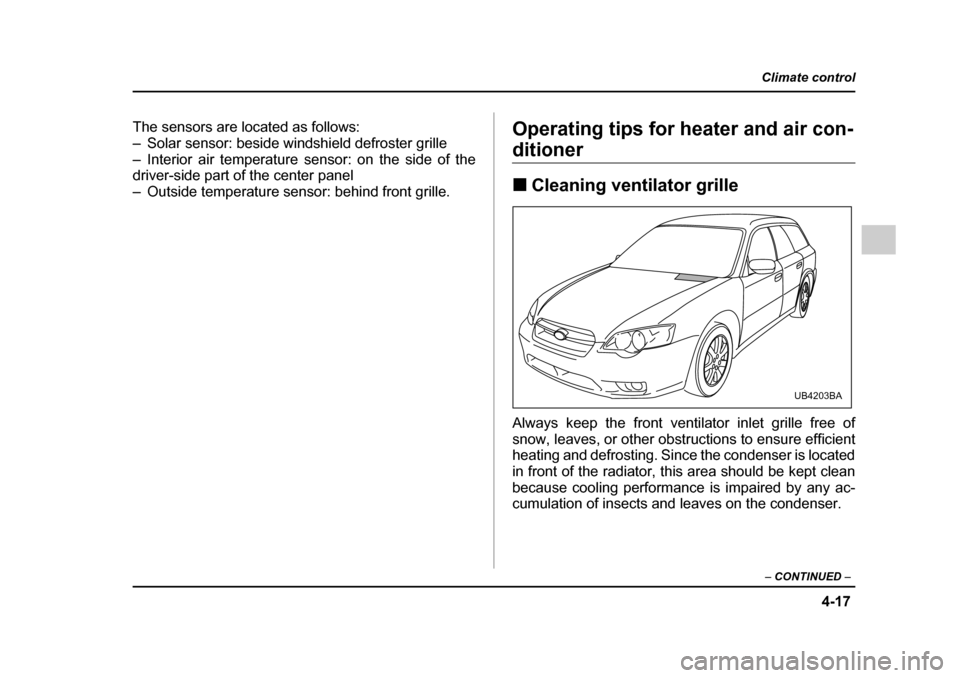
4-17
Climate control
– CONTINUED –
The sensors are located as follows:
– Solar sensor: beside windshield defroster grille
– Interior air temperature sensor: on the side of the
driver-side part of the center panel
– Outside temperature sensor: behind front grille. Operating tips for heater and air con-
ditioner !
Cleaning ventilator grille
Always keep the front ventilator inlet grille free of
snow, leaves, or other obstructions to ensure efficient
heating and defrosting. Since the condenser is located
in front of the radiator, this area should be kept clean
because cooling performance is impaired by any ac-
cumulation of insects and leaves on the condenser.
UB4203BA
Page 404 of 627
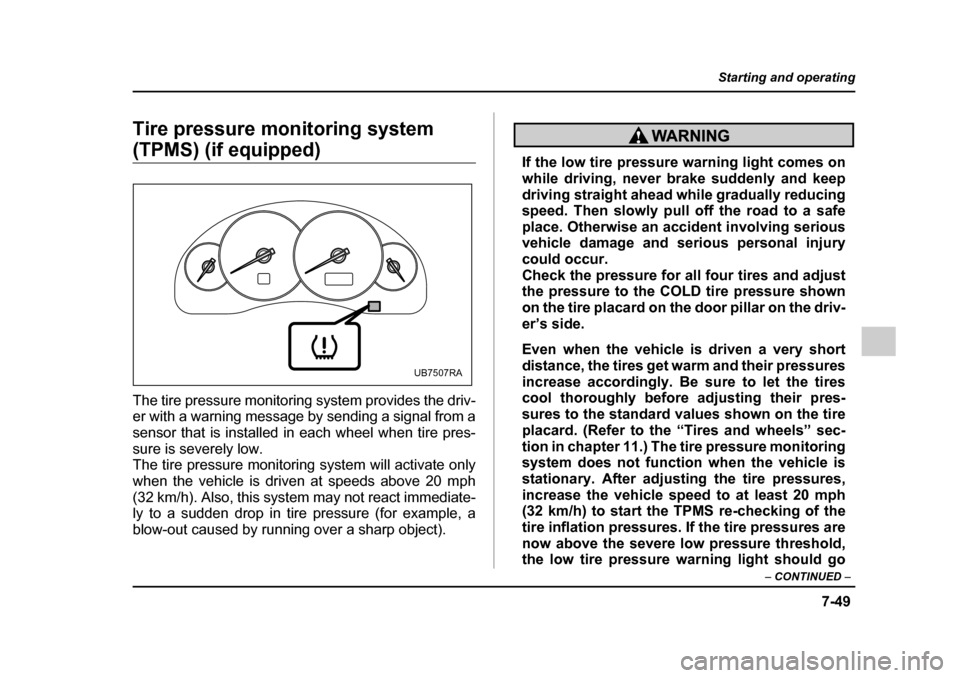
7-49
Starting and operating
– CONTINUED –
Tire pressure monitoring system
(TPMS) (if equipped)
The tire pressure monitoring system provides the driv-
er with a warning message by sending a signal from a
sensor that is installed in each wheel when tire pres-
sure is severely low.
The tire pressure monitoring system will activate only
when the vehicle is driven at speeds above 20 mph
(32 km/h). Also, this system may not react immediate-
ly to a sudden drop in tire pressure (for example, a
blow-out caused by running over a sharp object).If the low tire pressure warning light comes on
while driving, never brake suddenly and keep
driving straight ahead while gradually reducing
speed. Then slowly pull off the road to a safe
place. Otherwise an accident involving serious
vehicle damage and serious personal injury
could occur.
Check the pressure for all four tires and adjust
the pressure to the COLD tire pressure shown
on the tire placard on the door pillar on the driv-
er’s side.
Even when the vehicle is driven a very short
distance, the tires get warm and their pressures
increase accordingly. Be sure to let the tires
cool thoroughly before adjusting their pres-
sures to the standard values shown on the tire
placard. (Refer to the “Tires and wheels” sec-
tion in chapter 11.) The tire pressure monitoring
system does not function when the vehicle is
stationary. After adjusting the tire pressures,
increase the vehicle speed to at least 20 mph
(32 km/h) to start the TPMS re-checking of the
tire inflation pressures. If the tire pressures are
now above the severe low pressure threshold,
the low tire pressure warning light should go
UB7507RA
Page 405 of 627
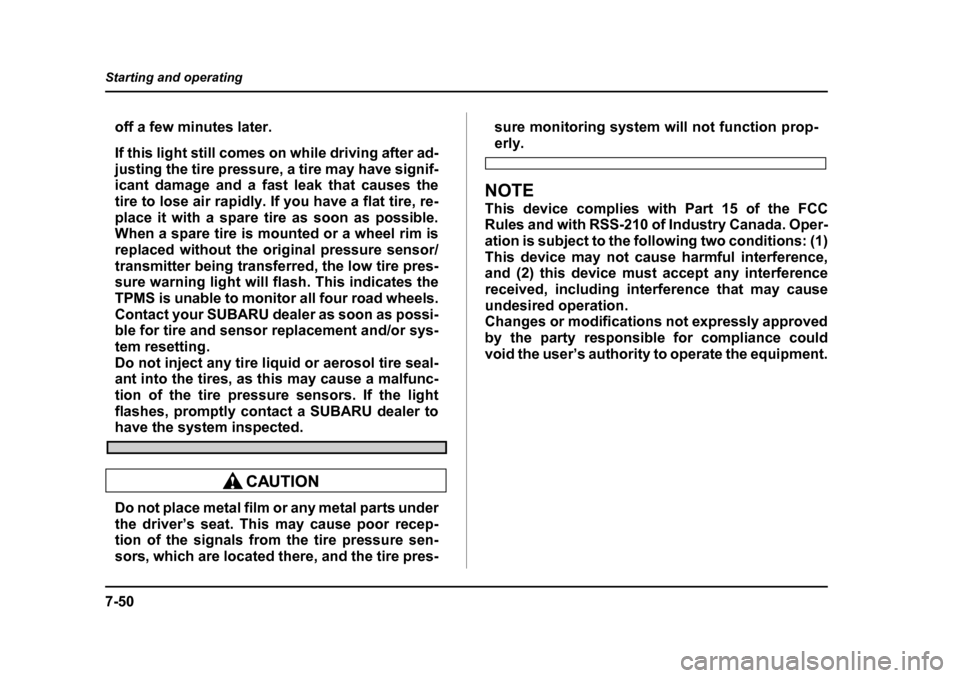
7-50
Starting and operating
off a few minutes later.
If this light still comes on while driving after ad-
justing the tire pressure, a tire may have signif-
icant damage and a fast leak that causes the
tire to lose air rapidly. If you have a flat tire, re-
place it with a spare tire as soon as possible.
When a spare tire is mounted or a wheel rim is
replaced without the original pressure sensor/
transmitter being transferred, the low tire pres-
sure warning light will flash. This indicates the
TPMS is unable to monitor all four road wheels.
Contact your SUBARU dealer as soon as possi-
ble for tire and sensor replacement and/or sys- tem resetting.
Do not inject any tire liquid or aerosol tire seal- ant into the tires, as this may cause a malfunc-
tion of the tire pressure sensors. If the light
flashes, promptly contact a SUBARU dealer to
have the system inspected.
Do not place metal film or any metal parts under
the driver’s seat. This may cause poor recep-
tion of the signals from the tire pressure sen-
sors, which are located there, and the tire pres-
sure monitoring system will not function prop-
erly.
NOTE
This device complies with Part 15 of the FCC
Rules and with RSS-210 of Industry Canada. Oper-ation is subject to the following two conditions: (1)
This device may not cause harmful interference,
and (2) this device must accept any interference
received, including interference that may cause
undesired operation.
Changes or modifications not expressly approved
by the party responsible for compliance could
void the user’s authority to operate the equipment.
Page 458 of 627
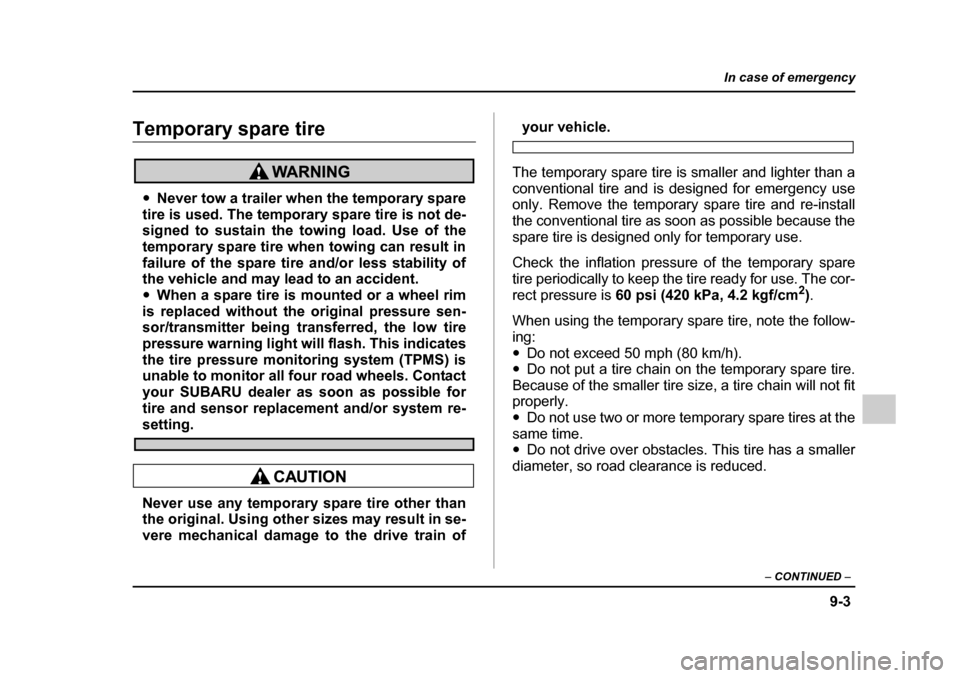
9-3
In case of emergency
– CONTINUED –
Temporary spare tire
"Never tow a trailer when the temporary spare
tire is used. The temporary spare tire is not de-
signed to sustain the towing load. Use of the
temporary spare tire when towing can result in
failure of the spare tire and/or less stability of
the vehicle and may lead to an accident. " When a spare tire is mounted or a wheel rim
is replaced without the original pressure sen-
sor/transmitter being transferred, the low tire
pressure warning light will flash. This indicates
the tire pressure monitoring system (TPMS) is
unable to monitor all four road wheels. Contact
your SUBARU dealer as soon as possible for
tire and sensor replacement and/or system re-
setting.
Never use any temporary spare tire other than
the original. Using other sizes may result in se-
vere mechanical damage to the drive train of
your vehicle.
The temporary spare tire is smaller and lighter than a
conventional tire and is designed for emergency use
only. Remove the temporary spare tire and re-install
the conventional tire as soon as possible because the
spare tire is designed only for temporary use.
Check the inflation pressure of the temporary spare
tire periodically to keep the tire ready for use. The cor-
rect pressure is 60 psi (420 kPa, 4.2 kgf/cm 2
).
When using the temporary spare tire, note the follow-
ing: " Do not exceed 50 mph (80 km/h).
" Do not put a tire chain on the temporary spare tire.
Because of the smaller tire size, a tire chain will not fit
properly. " Do not use two or more temporary spare tires at the
same time. " Do not drive over obstacles. This tire has a smaller
diameter, so road clearance is reduced.
Page 471 of 627
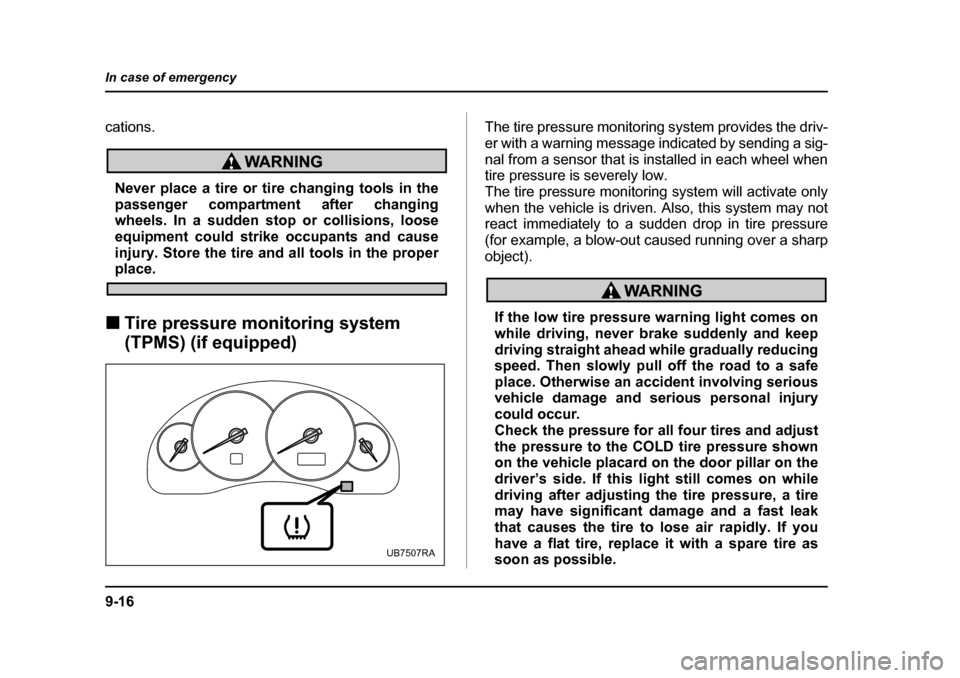
9-16
In case of emergency
cations.
Never place a tire or tire changing tools in the
passenger compartment after changing
wheels. In a sudden stop or collisions, loose
equipment could strike occupants and cause
injury. Store the tire and all tools in the proper
place.
! Tire pressure monitoring system
(TPMS) (if equipped) The tire pressure monitoring system provides the driv-
er with a warning message indicated by sending a sig-
nal from a sensor that is installed in each wheel when
tire pressure is severely low.
The tire pressure monitoring system will activate only
when the vehicle is driven. Also, this system may not
react immediately to a sudden drop in tire pressure
(for example, a blow-out caused running over a sharp
object).
If the low tire pressure warning light comes on
while driving, never brake suddenly and keep
driving straight ahead while gradually reducing
speed. Then slowly pull off the road to a safe
place. Otherwise an accident involving serious
vehicle damage and serious personal injury
could occur.
Check the pressure for all four tires and adjust
the pressure to the COLD tire pressure shown
on the vehicle placard on the door pillar on the
driver’s side. If this light still comes on while
driving after adjusting the tire pressure, a tire
may have significant damage and a fast leak
that causes the tire to lose air rapidly. If you
have a flat tire, replace it with a spare tire as
soon as possible.
UB7507RA
Page 472 of 627
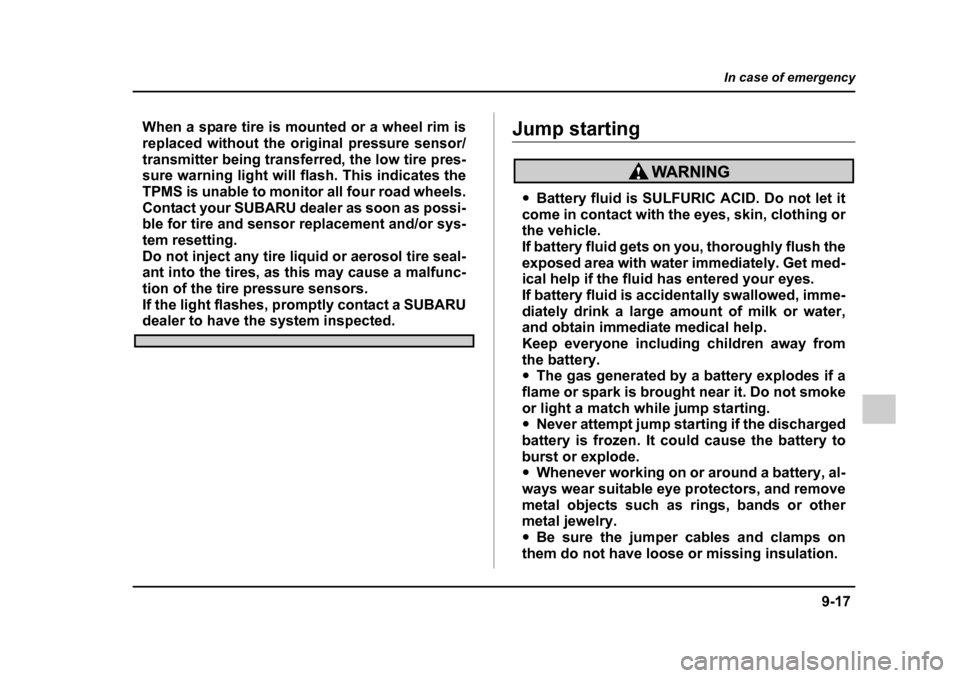
9-17
In case of emergency
– CONTINUED –
When a spare tire is mounted or a wheel rim is
replaced without the original pressure sensor/
transmitter being transferred, the low tire pres-
sure warning light will flash. This indicates the
TPMS is unable to monitor all four road wheels.
Contact your SUBARU dealer as soon as possi-
ble for tire and sensor replacement and/or sys-
tem resetting.
Do not inject any tire liquid or aerosol tire seal-
ant into the tires, as this may cause a malfunc-
tion of the tire pressure sensors.
If the light flashes, promptly contact a SUBARU
dealer to have the system inspected.
Jump starting
"Battery fluid is SULFURIC ACID. Do not let it
come in contact with the eyes, skin, clothing or
the vehicle.
If battery fluid gets on you, thoroughly flush the
exposed area with water immediately. Get med-
ical help if the fluid has entered your eyes.
If battery fluid is accidentally swallowed, imme-
diately drink a large amount of milk or water,
and obtain immediate medical help.
Keep everyone including children away from the battery." The gas generated by a battery explodes if a
flame or spark is brought near it. Do not smoke
or light a match while jump starting." Never attempt jump starting if the discharged
battery is frozen. It could cause the battery to
burst or explode." Whenever working on or around a battery, al-
ways wear suitable eye protectors, and remove
metal objects such as rings, bands or other
metal jewelry. " Be sure the jumper cables and clamps on
them do not have loose or missing insulation.
Page 494 of 627
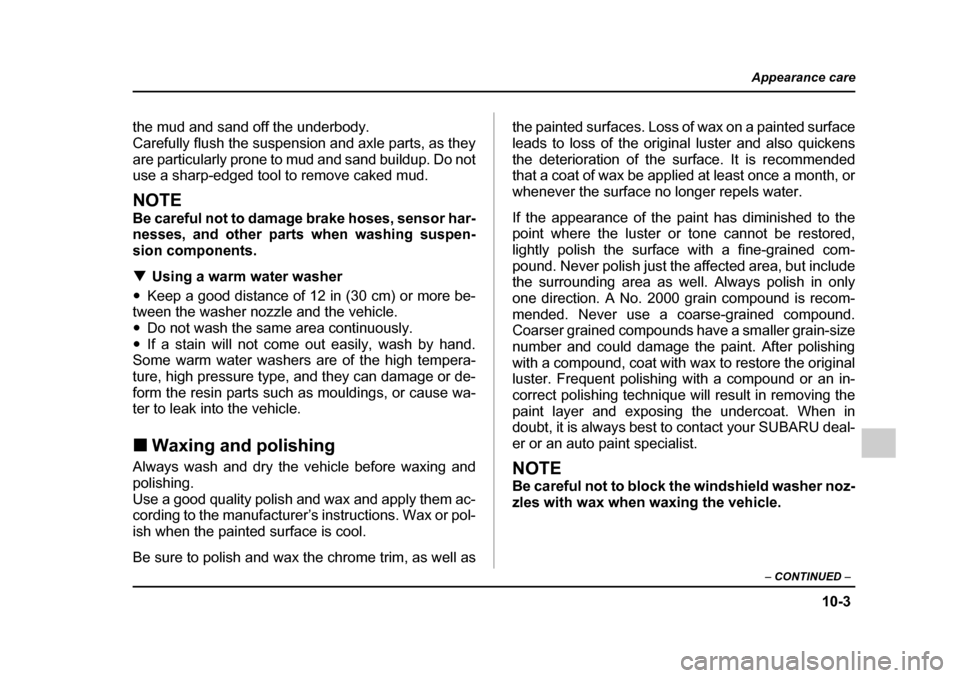
10-3
Appearance care
– CONTINUED –
the mud and sand off the underbody.
Carefully flush the suspension and axle parts, as they
are particularly prone to mud and sand buildup. Do not
use a sharp-edged tool to remove caked mud.
NOTE
Be careful not to damage brake hoses, sensor har-
nesses, and other parts when washing suspen-
sion components. !Using a warm water washer
" Keep a good distance of 12 in (30 cm) or more be-
tween the washer nozzle and the vehicle. " Do not wash the same area continuously.
" If a stain will not come out easily, wash by hand.
Some warm water washers are of the high tempera-
ture, high pressure type, and they can damage or de-
form the resin parts such as mouldings, or cause wa-
ter to leak into the vehicle. ! Waxing and polishing
Always wash and dry the vehicle before waxing and
polishing.
Use a good quality polish and wax and apply them ac-
cording to the manufacturer’s instructions. Wax or pol-
ish when the painted surface is cool.
Be sure to polish and wax the chrome trim, as well as the painted surfaces. Loss of wax on a painted surface
leads to loss of the original luster and also quickens
the deterioration of the surface. It is recommended
that a coat of wax be applied at least once a month, or
whenever the surface no longer repels water.
If the appearance of the paint has diminished to the
point where the luster or tone cannot be restored,
lightly polish the surface with a fine-grained com-
pound. Never polish just the affected area, but include
the surrounding area as well. Always polish in only
one direction. A No. 2000 grain compound is recom-
mended. Never use a coarse-grained compound.
Coarser grained compounds have a smaller grain-size
number and could damage the paint. After polishing
with a compound, coat with wax to restore the original
luster. Frequent polishing with a compound or an in-
correct polishing technique will result in removing the
paint layer and exposing the undercoat. When in
doubt, it is always best to contact your SUBARU deal-
er or an auto paint specialist.
NOTE
Be careful not to block the windshield washer noz-
zles with wax when waxing the vehicle.
Page 548 of 627

11 -4 9
Maintenance and service
– CONTINUED –
Tires and wheels !Types of tires
You should be familiar with type of tires present on your vehicle. ! All season tires
The factory-installed tires on your new vehicle are all
season tires.
All season tires are designed to provide an adequate
measure of traction, handling and braking perfor-
mance in year-round driving including snowy and icy
road conditions. However all season tires do not offer
as much traction performance as winter (snow) tires in
heavy or loose snow or on icy roads.
All season tires are identified by “ALL SEASON” and/
or “M+S” (Mud & Snow) on the tire sidewall. ! Summer tires
Summer tires are high-speed capability tires best suit-
ed for highway driving under dry conditions.
Summer tires are inadequate for driving on slippery
roads such as on snow-covered or icy roads.
If you drive your vehicle on snow-covered or icy roads,
we strongly recommend the use of winter (snow) tires.
When installing winter tires, be sure to replace all four
tires. !
Winter (snow) tires
Winter tires are best suited for driving on snow-cov-
ered and icy roads. However winter tires do not per-
form as well as summer tires and all season tires on
roads other than snow-covered and icy roads. ! Tire pressure monitoring system
(TPMS) (if equipped)
The tire pressure monitoring system provides the driv-
er with a warning message indicating by sending a sig-
nal from a sensor that is installed in each wheel when
tire pressure is severely low. The tire pressure moni-
toring system will activate only when the vehicle is
driven. Also, this system may not react immediately to
a sudden drop in tire pressure (for example, a blow-
out caused by running over a sharp object).
If you adjust the tire pressures in a warm garage and
will then drive the vehicle in cold outside air, the result-
ing drop in tire pressures may cause the low tire pres-
sure warning light to come on. To avoid this problem
when adjusting the tire pressures in a warm garage,
inflate the tires to pressures higher than those shown
on the tire placard. Specifically, inflate them by an ex-
tra 1 psi (6.9 kPa, 0.07 kgf/cm 2
) for every difference of
10 °F (5.6 °C) between the temperature in the garage
and the temperature outside. By way of example, the
Page 549 of 627

11 - 5 0
Maintenance and service
following table shows the required tire pressures that
correspond to various outside temperatures when the
temperature in the garage is 60
°F (15.6 °C).
Standard tire pressures:
Front: 32 psi (220 kPa, 2.2 kgf/cm 2
)
Rear: 30 psi (210 kPa, 2.1 kgf/cm 2
)
Garage temperature: 60 °F (15.6 °C)
If the low tire pressure warning light comes on when
you drive the vehicle in cold outside air after adjusting
the tire pressures in a warm garage, re-adjust the tire
pressures using the method described above. Then,
increase the vehicle speed to at least 20 mph (32 km/
h) and check to see that the low tire pressure warning
light goes off a few minutes later. If the low tire pres-
sure warning light does not go off, the tire pressure
monitoring system may not be functioning normally. In this event, go to a SUBARU dealer to have the system
inspected as soon as possible.
While the vehicle is driven, friction between tires and
the road surface causes the tires to warm up. After il-
lumination of the low tire pressure warning light, any
increase in the tire pressures caused by an increase in
the outside air temperature or by an increase in the
temperature in the tires can cause the low tire pres-
sure warning light to go off.
System resetting is necessary when the wheels are
changed (for example, a switch to snow tires) and new
TPMS valves are installed on the newly fitted wheels.
Have this work performed by a SUBARU dealer fol-
lowing wheel replacement.
It may not be possible to install TPMS valves on cer-
tain wheels that are on the market. Therefore, if you
change the wheels (for example, a switch to snow
tires), use wheels that have the same part number as
the standard-equipment wheels. Without four opera-
tional TPMS valve/sensors on the wheels, the TPMS
will not fully function and the warning light in the instru-
ment panel will flash.
When a tire is replaced, adjustments are necessary to
ensure continued normal operation of the tire pressure
monitoring system. As with wheel replacement, there-
Outside temperature Adjusted pressure
[psi (kPa, kgf/cm2
)]
front rear
30 °F (–1 °C) 35 (240, 2.4) 33 (230, 2.3)
10 °F (–12 °C) 37 (255, 2.55) 35 (245, 2.45)
–10 °F (–23 °C) 39 (270, 2.7) 37 (260, 2.6)
Page 550 of 627
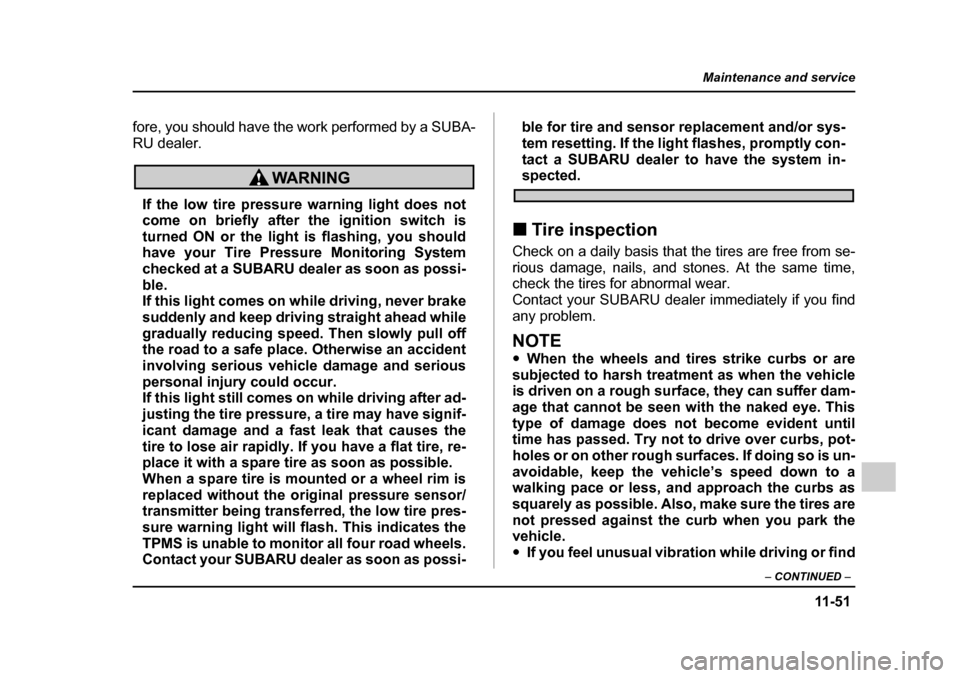
11 -5 1
Maintenance and service
– CONTINUED –
fore, you should have the work performed by a SUBA-
RU dealer.
If the low tire pressure warning light does not
come on briefly after the ignition switch is
turned ON or the light is flashing, you should
have your Tire Pressure Monitoring System
checked at a SUBARU dealer as soon as possi-
ble.
If this light comes on while driving, never brake
suddenly and keep driving straight ahead while
gradually reducing speed. Then slowly pull off
the road to a safe place. Otherwise an accident
involving serious vehicle damage and serious
personal injury could occur.
If this light still comes on while driving after ad-
justing the tire pressure, a tire may have signif-
icant damage and a fast leak that causes the
tire to lose air rapidly. If you have a flat tire, re-
place it with a spare tire as soon as possible.
When a spare tire is mounted or a wheel rim is
replaced without the original pressure sensor/
transmitter being transferred, the low tire pres-
sure warning light will flash. This indicates the
TPMS is unable to monitor all four road wheels.
Contact your SUBARU dealer as soon as possi- ble for tire and sensor replacement and/or sys-
tem resetting. If the light flashes, promptly con-
tact a SUBARU dealer to have the system in-
spected.
! Tire inspection
Check on a daily basis that the tires are free from se-
rious damage, nails, and stones. At the same time,
check the tires for abnormal wear.
Contact your SUBARU dealer immediately if you find
any problem.
NOTE " When the wheels and tires strike curbs or are
subjected to harsh treatment as when the vehicle
is driven on a rough surface, they can suffer dam-
age that cannot be seen with the naked eye. This
type of damage does not become evident until
time has passed. Try not to drive over curbs, pot-
holes or on other rough surfaces. If doing so is un-
avoidable, keep the vehicle’s speed down to a
walking pace or less, and approach the curbs as
squarely as possible. Also, make sure the tires are
not pressed against the curb when you park thevehicle. " If you feel unusual vibration while driving or find